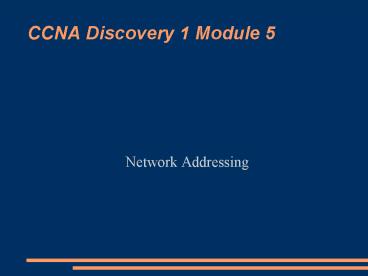CCNA Discovery 1 Module 5 - PowerPoint PPT Presentation
1 / 14
Title:
CCNA Discovery 1 Module 5
Description:
Subnet Masks ... Default Subnet Masks. Class A is 255.0.0.0 or /8. Class B is 255. ... Subnet Mask. Default Gateway. DNS Server. DNS Domain Name. Many more... – PowerPoint PPT presentation
Number of Views:331
Avg rating:5.0/5.0
Title: CCNA Discovery 1 Module 5
1
CCNA Discovery 1 Module 5
- Network Addressing
2
Network Addresses
- IPv4
- Ipv6
- AppleTalk
- IPX
3
IP Address Purpose
- A host needs an IP address to communicate on the
Internet - The address must be unique and properly
configured - Packets traversing the Internet have a source and
destination IP address specified within them - The address is assigned to the NIC on the host
4
Base Conversions
- Binary is Base 2
- Decimal is Base 10
- Hexadecimal is Base 16
5
IP Address Structure
- 32 bits long
- Represented as four decimal numbers separated by
a dot (dotted-decimal)? - Each position in dotted-decimal notation
represents eight bits, or one octet - 32 bit addresses are specified by IPv4
6
Subnet Masks
- Determine which portion of an IP address
identifies the host and which portion identifies
the network - Binary 1s in a subnet mask identify network bits
- Binary 0s in a subnet mask identify host bits
- May be written in dotted-decimal notation
(255.255.0.0)? - May be written in slash or CIDR notation (/16)?
7
Network Classes
- Determined by the first octet of the address
- 0-127 is Class A
- 128-191 is Class B
- 192-223 is Class C
- 224-239 is Class D (Multicasting)?
- 240-255 is Class E (Experimental Use)?
- Default Subnet Masks
- Class A is 255.0.0.0 or /8
- Class B is 255.255.0.0 or /16
- Class C is 255.255.255.0 or /24
8
Special Addresses
- Network ID
- Host portion of address is all 0s
- Broadcast
- Host portion of address is all 1s
- Multicast
- Class D Address
- Dest. MAC Address begins with 01-00-5E
- Dest. MAC Address ends with last 23 bits of IP
address converted into hex.
9
Private Networks
- 127.0.0.0/8 is reserved for loopback testing
- 10.0.0.0/8 is a Class A private network
- 172.16.0.0/16 172.31.0.0/16 are 16 Class B
private networks - 192.168.0.0/24 192.168.255.0/24 are 256 Class C
private networks - 169.254.0.0/16 is a private Class B network for
APIPA
10
Network Boundaries
- Network addresses must exist within confined
regions - Network boundaries are typically identified by
router interfaces - Remember that routers are also boundaries for
broadcasts, thus DHCP is stopped at these
boundaries without the use of a relay agent
11
Getting an IP Address
- Static Assignment
- The administrator configures the address manually
- DHCP
- Address are received from a Dynamic Host
Configuration Protocol server - APIPA
- Automatic Private IP Addressing, for use in
networks configured for DHCP when no DHCP server
is available
12
DHCP
- Host broadcasts a DHCP Discover to find available
DHCP servers/addresses - Server(s) unicast a DHCP Offer to the host with a
suggested IP address - Host unicasts a DHCP Request to the server,
asking to use a specified IP address - The server unicasts a DHCP Acknowledgment (ACK)
to the host - Under some circumstances, the server may unicast
a DHCP Negative Acknowledgment (NACK), which
rejects the host's DHCP Request
13
DHCP (cont'd)?
- DHCP can provide the following items to a host
- IP Address
- Subnet Mask
- Default Gateway
- DNS Server
- DNS Domain Name
- Many more...
14
NAT (Network Address Translation)?
- Used to translate addresses from one network to
another - Most commonly used to translate private addresses
to public addresses































